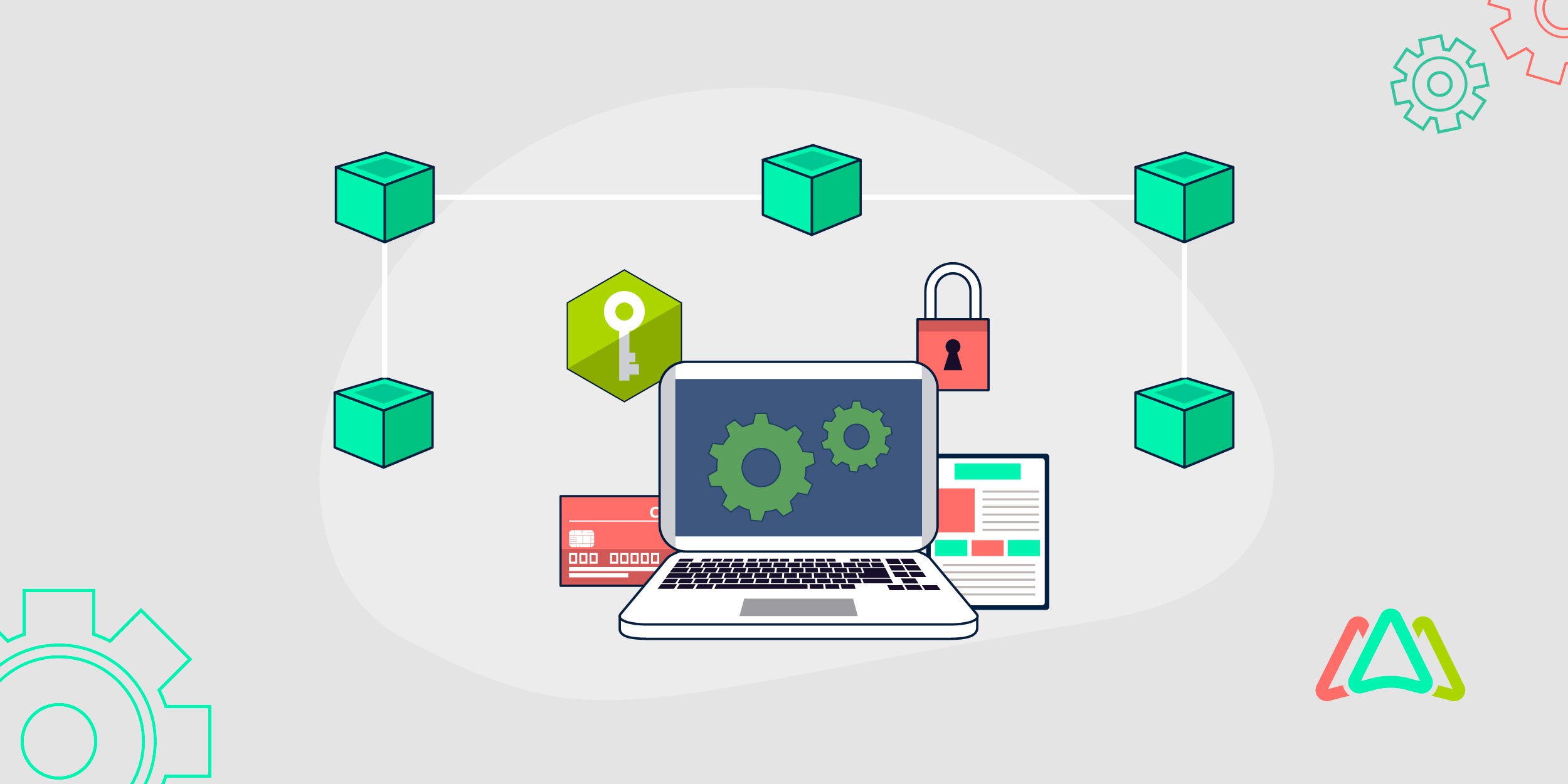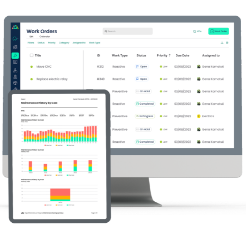
Blockchain for CMMS
Imagine you're going through a compliance audit, and the inspector asks for maintenance records from three years ago. Your heart sinks because you know those records are unreliable, having been documented using multiple platforms and without being standardized. If you're a maintenance or facilities manager, you've likely lived this nightmare. Every compromised maintenance record isn't just a data problem; it's a compliance problem. It can result in costly fines, compromising your asset history data, and liability issues that can shut down your operations.
But what if there's a way to make your maintenance records completely transparent and secure? Today's technology makes this possible by creating an immutable digital ledger that transforms fragmented maintenance data into an unbreakable chain of verified transactions. That's the possibilities of blockchain for CMMS.

What Does Blockchain Bring to CMMS?
You've probably heard "blockchain" thrown around with cryptocurrency, but here's what it means for your maintenance operation.
A blockchain-enabled CMMS is a cutting-edge maintenance management system that unites cryptographically secured data integrity with conventional record-keeping. From the creation of work orders to the retirement of assets, it continually verifies each maintenance transaction using distributed consensus techniques that virtually eliminate data manipulation.
It's like having a maintenance logbook that's simultaneously stored in dozens of secure vaults, and every entry needs approval from multiple trusted witnesses before it gets written in permanent ink.
A blockchain-enabled CMMS supercharges your traditional maintenance management system. Every work order, repair record, and parts replacement is validated and locked into an unbreakable chain of verified transactions.
To understand how this technology works in practice, let's examine the core architecture that makes blockchain CMMS possible.
Architecture of Blockchain-Enabled CMMS
The blockchain CMMS operates through four layers that work together seamlessly. Here is a breakdown:
1. Smart Contracts - The Automation Layer
The smart contract immediately generates a work order, assigns it to the appropriate technician, and even orders the necessary components when your temperature sensor detects that your equipment is overheating, with no delays, phone calls, or human error.
IBM is already doing this with its blockchain-based maintenance contracts. The system automatically initiates warranty claims when equipment malfunctions during the warranty period. This is an automatic process involving no paperwork and disagreements.
2. The Blockchain Network - Your Distributed Ledger
This is where all your maintenance records live, spread across multiple secure nodes. Think of it as having backup copies of your most important files stored in multiple bank vaults. Even if one location goes down, your records are safe and accessible.
3. Integration Layers - The Bridge
These connect your existing CMMS to the blockchain network. You don't have to throw away your current system; the integration layer is a translator, syncing data between your familiar interface and the blockchain's security.
4. User Interface - What You See
This is your user dashboard, where you can track performance and look at trends. You can trust that the blockchain network has verified and secured every data point.
Why Maintenance Teams are Adopting Blockchain CMMS
The transformation to blockchain CMMS is driven by six compelling advantages that address critical maintenance challenges.
Immutable maintenance records
Creating a permanent audit trail from work order creation to equipment retirement will be very useful during regulatory inspections and legal proceedings. Industries such as aviation and pharmaceuticals consider blockchain's tamper-proof nature important for compliance and protection against liability.
Enhanced multi-vendor collaboration
This permits numerous contractors, suppliers, and internal teams to have safe access to and update maintenance records without sacrificing data integrity. The same validated information is shown to both parties. In intricate maintenance ecosystems, this minimizes disagreements over finished work and lowers administrative overhead.
Automated compliance and auditing
In order to improve oversight and streamline the auditing process, smart contracts can continuously monitor maintenance activities against regulatory requirements, flag non-compliance automatically, and generate audit reports in real-time by eliminating the need for manual tracking and filling in documentation gaps.
Improved asset lifecycle management
Blockchain-CMMS keeps complete, tamper-proof histories from procurement to disposal. This includes all maintenance activities and performance changes. This full record is extremely useful for warranty claims, resale negotiations, and life cycle cost analysis.
Cost reduction through transparency
By eliminating redundant maintenance data and creating a single, validated source of truth, blockchain aids in the prevention of fraudulent maintenance claims. This ensures that maintenance data is more accurate, accountable, and trustworthy across the organization.
Tamper-proof warranty logs
Blockchain ensures that warranty data, such as service history, parts replacement, and usage conditions, remains immutable and verifiable. This is especially critical in regulated industries like aviation and manufacturing, where unauthorized changes to maintenance logs can lead to safety risks, compliance violations, or costly warranty disputes.
How to Implement Blockchain in Your CMMS
Implementing blockchain isn’t a plug-and-play process. A successful blockchain implementation follows a straightforward eight-step process that minimizes risk while maximizing value:
Start by assessing current CMMS capabilities
Look at your current CMMS and identify your most significant pain points. Where are you losing data integrity? What compliance gaps exist? Document everything and establish baseline metrics.
Define specific blockchain use cases
Don't try to blockchain everything at once. Pick your highest-impact challenges, multi-vendor collaboration or compliance automation, and focus on areas where blockchain's security provides immediate value.
Choose appropriate blockchain platforms
Platforms like Hyperledger Fabric and VeChain are designed explicitly for maintenance applications. Evaluate how they integrate with your existing CMMS, ERP, and IoT systems.
Design smart contracts
Create automated workflows for your most critical processes, including work order approval, parts ordering, and compliance verification. Test everything thoroughly before going live.
Establish network governance
Define who can participate in your network, establish data privacy policies, and create access controls that comply with your industry regulations.
Integrate with existing systems.
Connect your existing systems using APIs and middleware. During the transition, maintain consistency between blockchain records and your traditional databases.
Train teams and users
Your team needs to understand how to use the new system and why it benefits them. Focus on the value, not the technical complexity.
Deploy through controlled pilots
Begin with a test project on non-critical assets. Monitor performance, identify improvements, and then gradually expand implementation.
Blockchain CMMS Challenges & Mitigation Strategies
While blockchain offers powerful benefits for maintenance management, it’s not without its hurdles. From technical complexity to user adoption, organizations must navigate several challenges to implement and scale a blockchain-enabled CMMS successfully. The following are the key obstacles and practical strategies to overcome them:
Technical complexity and integration
Blockchain requires specialized expertise. But here's the good news: blockchain-as-a-service providers offer managed platforms with integration support. You don't need to become a blockchain expert overnight.
Performance and scalability
Limitations may cause delays in high-volume maintenance operations. Layer-2 solutions and hybrid architectures combining blockchain security with traditional database performance effectively address these limitations.
Change management and user adoption
Your team might resist new processes. Combat this with comprehensive training, gradual implementation, and clear communication about benefits rather than technical details.
Regulatory and compliance uncertainty
Work with legal experts familiar with blockchain technology and participate in industry consortia developing blockchain standards for maintenance.
As these challenges are addressed, the future of blockchain CMMS promises even more transformative capabilities. The following is a list of some of these capabilities:
Interoperability with Legacy Systems
Integrating blockchain with existing CMMS or ERP platforms can be challenging. Custom adapters or middleware are required to ensure seamless data exchange without disrupting current workflows.
Data Privacy When Sharing Across Vendors
While blockchain promotes transparency, sharing sensitive maintenance data across vendors must be carefully managed to protect proprietary information and comply with data protection regulations.

The Future of Blockchain CMMS
The future of blockchain CMMS is exciting. Artificial intelligence based on blockchain-verified sensor data will be integrated with digital twins and IoT to create comprehensive asset models combining real-time monitoring with immutable maintenance histories.
Predictive maintenance algorithms will automatically validate warranty claims using secure, timestamped service records. Tokenized incentives may gamify maintenance reporting, rewarding teams for timely and accurate updates. We'll also see industry-wide maintenance data consortia where organizations can benchmark performance while maintaining competitive confidentiality, all protected by quantum-resistant cryptography.
As these systems evolve, blockchain will enable autonomous maintenance decisions powered by AI and IoT collaboration, turning data into proactive action.
Conclusion - Trust and Transparency in CMMS
Blockchain CMMS technology has the potential to revolutionize maintenance operations by shifting from reactive record-keeping to proactive, data-driven optimization. With tamper-proof records and automated smart contracts, maintenance teams gain audit-ready compliance, significantly reduced administrative overhead, and trusted, verifiable insights into asset performance and service history.
This level of transparency promotes better decision-making, especially in multi-vendor environments where coordination is critical. Whether you're managing complex manufacturing systems, sensitive healthcare devices, or mission-critical energy infrastructure, a blockchain-enabled CMMS minimizes data vulnerabilities, enhances accountability, and streamlines compliance. The result is measurable ROI through lower regulatory costs, extended asset lifespan, and improved operational efficiency.
TABLE OF CONTENTS
Keep Reading
By 2026, CMMS platforms will no longer be the limiting factor in maintenance performance. ...
30 Dec 2025
Spare parts management within maintenance can make the difference between a problem-free ...
16 Dec 2025
Every maintenance team eventually faces the same question: When should we repair, and when ...
12 Dec 2025
Enterprise Asset Management (EAM) software has become a cornerstone for organizations aiming ...
12 Dec 2025
Unexpected equipment breakdowns can disrupt operations, increase repair costs, and reduce ...
11 Dec 2025
Businesses are always looking for ways to improve efficiencies, reduce costs, and improve ...
9 Dec 2025
The longest U.S. federal government shutdown to date lasted 43 days, beginning on October 1, ...
5 Dec 2025
Every maintenance professional faces it sooner or later — that critical time when an aging ...
18 Nov 2025
The term 'best' is often used loosely, without a clear understanding of its context or ...
14 Nov 2025
In the not too distant past, maintenance strategies have been defined by reaction—fixing ...
13 Nov 2025
Tax season is the time of year that often sends a ripple of anxiety through many of us. The ...
11 Nov 2025
Selecting a Computerized Maintenance Management System (CMMS) can, at first glance, be an ...
4 Nov 2025
In healthcare facilities, equipment uptime involves more than achieving operational ...
31 Oct 2025
Companies are subject to economic ups and downs, also known as economic volatility. Today, ...
30 Oct 2025
Maintenance challenges are a constant struggle, with unplanned downtime costing manufacturers ...
27 Oct 2025
Last winter, a maintenance technician at a U.S. paper mill ignored a predictive alert that ...
10 Oct 2025
Many organizations proudly say they “have a CMMS,” but ownership alone doesn’t equal ...
9 Oct 2025
Every maintenance team is under pressure to do more with less. Unplanned downtime is often ...
7 Oct 2025
The implementation of simple, yet powerfully effective, checklists has repeatedly ...
3 Oct 2025
In manufacturing, every second counts. When production stops, whether due to scheduled ...
2 Oct 2025





